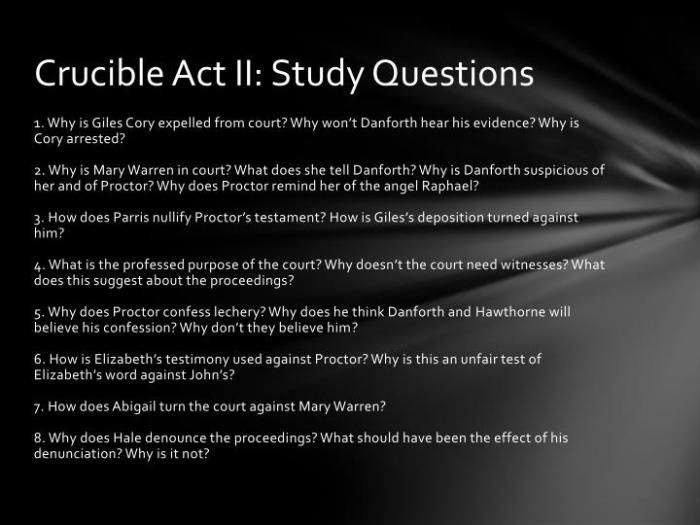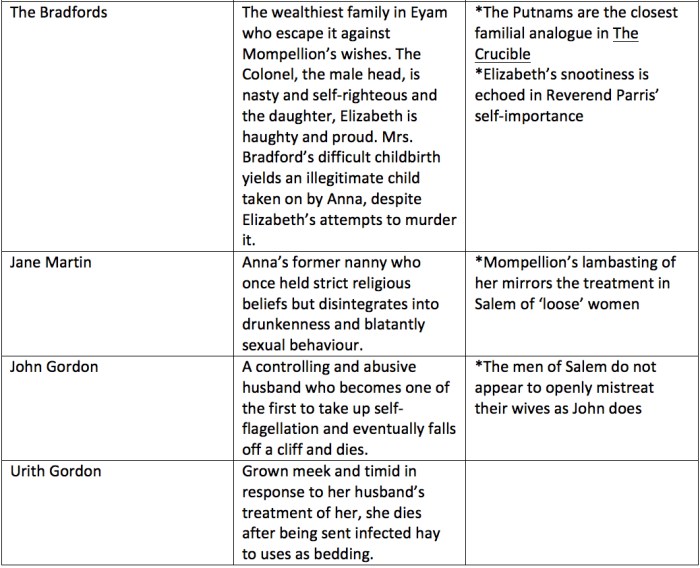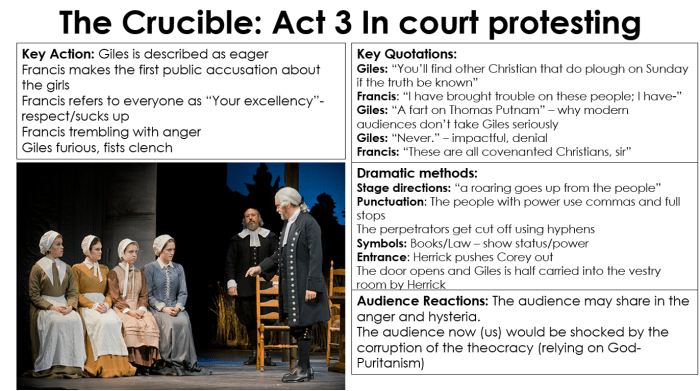Act 3 the crucible answers – Act 3 of The Crucible answers provides an intriguing and in-depth examination of the pivotal events, character development, and thematic exploration that drive this captivating play.
The act unfolds with a series of crucial confrontations and moral dilemmas that shape the destinies of the characters and the outcome of the play.
Key Events and Conflicts
Act 3 of The Crucible marks a pivotal moment in the play, characterized by dramatic confrontations and heightened tensions. Several key events unfold, intensifying the conflicts between characters and exposing their motivations.
A central conflict in Act 3 arises between John Proctor and Abigail Williams. Proctor confronts Abigail, accusing her of witchcraft and exposing her lies. Abigail, driven by her desire for Proctor, retaliates by accusing his wife, Elizabeth, of witchcraft. This accusation further fuels the hysteria in the town, leading to Elizabeth’s arrest.
Abigail’s Accusations
Abigail’s accusations against Elizabeth Proctor stem from her unrequited love for John Proctor and her desire to eliminate her rival. By accusing Elizabeth, Abigail aims to remove the obstacle that stands between her and Proctor.
Abigail’s motivations are driven by her selfish desires and her willingness to manipulate others to achieve her goals. Her actions contribute to the escalating tension and chaos in the town.
Character Analysis: Abigail Williams

Abigail Williams is a complex and manipulative character who plays a significant role in the events of Act 3. Her actions and motivations are driven by her desire for power and revenge.
In Act 3, Abigail continues to manipulate the events of the play to her advantage. She accuses Mary Warren of witchcraft, knowing that Mary is innocent. This accusation is an attempt to silence Mary and prevent her from testifying against Abigail.
Abigail’s actions in Act 3 also reveal her ruthless and ambitious nature. She is willing to do whatever it takes to achieve her goals, even if it means hurting others.
Abigail’s Role in Manipulating the Events of the Play
- Abigail accuses Mary Warren of witchcraft to silence her and prevent her from testifying against her.
- Abigail uses her power over the other girls to control their testimony and influence the outcome of the trials.
- Abigail’s manipulation of the events of the play ultimately leads to the deaths of innocent people.
Character Analysis: John Proctor
John Proctor faces a profound moral crisis in Act 3, wrestling with his integrity, duty, and desire for redemption. His choices and struggles shape the play’s trajectory and illuminate the complexities of his character.
Proctor’s Moral Dilemma
Proctor’s moral dilemma stems from his affair with Abigail Williams and the subsequent accusations of witchcraft against his wife, Elizabeth. He grapples with the guilt of his infidelity and the realization that his actions have endangered Elizabeth’s life. His struggle between self-preservation and the need to protect his loved ones drives his choices throughout the act.
Consequences of Proctor’s Actions
Proctor’s decision to confess to his affair and expose Abigail’s deception has far-reaching consequences. It undermines the authority of the court and the credibility of the accusations, leading to the eventual downfall of the witch trials. However, his confession also seals his own fate, as he is arrested and condemned to death for witchcraft.
Themes and Motifs

Act 3 of The Crucible delves deeper into the play’s central themes and motifs, exploring the complexities of human nature, the dangers of mass hysteria, and the search for truth and justice.
The Power of Accusation
- Abigail’s false accusations against John Proctor escalate the hysteria in Salem, demonstrating the devastating power of baseless allegations.
- The citizens of Salem blindly accept the accusations, revealing the susceptibility of communities to fear and prejudice.
The Erosion of Trust
- The accusations shatter the bonds of trust within the community, as neighbors turn against each other.
- John Proctor’s refusal to lie for Abigail exposes the fragility of truth and the ease with which it can be manipulated.
The Search for Truth
- Reverend Hale’s arrival in Salem highlights the importance of finding the truth and exposing the false accusations.
- John Proctor’s determination to clear his name, even at the cost of his life, demonstrates the human spirit’s resilience in the face of adversity.
Symbolism and Imagery
Act 3 of The Crucibleis rife with symbolism and imagery that enhance the play’s themes and character development. These elements create a vivid and evocative atmosphere, immersing the audience in the play’s setting and the characters’ inner struggles.
One of the most striking symbols in Act 3 is the fire. The fire that consumes Abigail’s home is a physical manifestation of the destructive power of the witch hunt. It also represents the danger of unchecked authority and the mob mentality that has gripped Salem.
The Witchcraft Trials as a Crucible
The play’s title, The Crucible, also carries significant symbolic weight. A crucible is a container in which metals are heated to extreme temperatures to purify them. In the play, the town of Salem becomes a crucible in which the characters are tested and their true natures are revealed.
Need a quick refresher on Act 3 of The Crucible? Look no further! And while you’re at it, did you know that the psia level 1 pass rate is an indicator of success in the field? So, brush up on both subjects and ace your exams!
The witch trials serve as a catalyst for exposing the hypocrisy, fear, and greed that lurk beneath the surface of the community.
The Dance in the Woods
The dance in the woods, during which Abigail and the other girls are caught by Reverend Parris, is another potent symbol. The dance represents the girls’ desire to break free from the strict Puritan society in which they live. It also foreshadows the chaos and destruction that will follow.
Abigail’s Bird
Abigail’s bird is a symbol of her power and her connection to the supernatural. The bird is a physical manifestation of her ability to control others and to manipulate events. It also represents her dark and dangerous nature.
The Imagery of Light and Darkness, Act 3 the crucible answers
The play also makes use of the imagery of light and darkness. Light represents truth, justice, and hope. Darkness represents ignorance, fear, and evil. The play’s climax occurs at night, when the forces of darkness are at their strongest. However, the play ends with a glimmer of hope, as John Proctor chooses to die a martyr for his beliefs.
Literary Devices: Act 3 The Crucible Answers
Act 3 of The Crucibleemploys various literary devices to heighten its dramatic impact and explore its themes.
One notable device is foreshadowing, which hints at future events and creates suspense. For instance, the ominous sound of drums in the distance foreshadows the arrival of the court officials and the impending trials.
Metaphor
Miller also uses metaphorsto create vivid imagery and convey complex ideas. For example, Abigail’s desire for John Proctor is described as a “beast” within her, symbolizing the destructive nature of her obsession.
Irony
Ironyis another powerful device used in Act 3. The fact that the court officials are seeking justice while themselves engaging in unjust actions highlights the hypocrisy and absurdity of the situation.
Symbolism
Symbolismplays a crucial role in the play. The fire that burns in the Proctor household represents both the passion and the destruction that Abigail’s accusations have brought upon Salem.
Imagery
Finally, imageryis used to create a vivid and evocative atmosphere. The darkness that envelops the town during the trials symbolizes the moral decay and fear that have consumed the community.
Historical Context

The Crucible is a play written by Arthur Miller in 1953 as an allegory of the McCarthy era, a period of intense political repression and persecution in the United States.
The play’s setting, the Salem witch trials of 1692, reflects the climate of fear and suspicion that prevailed during the McCarthy era. The witch hunt in Salem was a time of mass hysteria and paranoia, in which innocent people were accused of witchcraft and executed based on little or no evidence.
Political Climate
The McCarthy era was a period of intense political repression and persecution in the United States. The period is named after Senator Joseph McCarthy of Wisconsin, who made unsubstantiated accusations of communist infiltration in the State Department and other government agencies.
McCarthy’s accusations led to a series of congressional hearings and investigations, which resulted in the blacklisting of thousands of people from the entertainment industry, academia, and other professions. The McCarthy era ended in 1954 when McCarthy was censured by the Senate for his conduct.
Social Climate
The McCarthy era was a time of great social and political upheaval in the United States. The Cold War between the United States and the Soviet Union was at its height, and there was a widespread fear of communist infiltration.
This fear was fueled by the rise of communist China and the Korean War. The McCarthy era was also a time of great social change, as the United States underwent a period of rapid economic growth and urbanization.
Popular Questions
What are the key events that occur in Act 3?
Act 3 features the pivotal confrontation between Abigail and John Proctor, the revelation of Abigail’s manipulation, and the arrest of Elizabeth Proctor.
How does John Proctor’s moral struggle impact the outcome of the play?
Proctor’s decision to confess his adultery and expose Abigail’s lies ultimately leads to his execution, but it also serves as a testament to his integrity and the importance of truth.